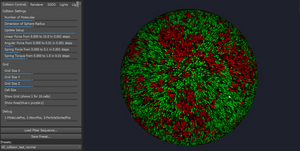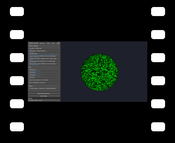Information
- Publication Type: Bachelor Thesis
- Workgroup(s)/Project(s):
- Date: January 2022
- Date (Start): 1. June 2021
- Date (End): 11. January 2022
- Matrikelnummer: 01427350
- First Supervisor: Eduard Gröller
Abstract
The molecular world is an exciting field of science. Since technology has advanced it is finally possible to discover the arrangements of the single atoms in molecules. With this data, complex systems like viruses, bacteria and cells, made out of millions of atoms can be modeled. Such systems are often called biological mesoscale structures and many visualization techniques have been developed to model them. This is not an easy task as such systems are very complex and need a lot of processing time to render. An essential part of the visualization is the collision detection and resolving as in the real world molecules do not overlap. We reimplemented the Fast Fixed-Radius Nearest Neighbors algorithm that was designed by Hoetzlein to find all colliding pairs of atoms, calculated forces which are then applied on the molecules in order to resolve the overlaps. To test this method we constructed a model of a lipid bilayer and found that it was able to resolve collisions with up to four million atoms in real time. We reviewed further improvements of our algorithm and are positive that it can be used as a efficient collision detection for mesoscale environments.Additional Files and Images
Weblinks
No further information available.BibTeX
@bachelorsthesis{Pauschenwein_2022,
title = "Real-Time Collision Detection and Handling of Molecules for
Animation and Modelling",
author = "Johannes Pauschenwein",
year = "2022",
abstract = "The molecular world is an exciting field of science. Since
technology has advanced it is finally possible to discover
the arrangements of the single atoms in molecules. With this
data, complex systems like viruses, bacteria and cells, made
out of millions of atoms can be modeled. Such systems are
often called biological mesoscale structures and many
visualization techniques have been developed to model them.
This is not an easy task as such systems are very complex
and need a lot of processing time to render. An essential
part of the visualization is the collision detection and
resolving as in the real world molecules do not overlap. We
reimplemented the Fast Fixed-Radius Nearest Neighbors
algorithm that was designed by Hoetzlein to find all
colliding pairs of atoms, calculated forces which are then
applied on the molecules in order to resolve the overlaps.
To test this method we constructed a model of a lipid
bilayer and found that it was able to resolve collisions
with up to four million atoms in real time. We reviewed
further improvements of our algorithm and are positive that
it can be used as a efficient collision detection for
mesoscale environments. ",
month = jan,
address = "Favoritenstrasse 9-11/E193-02, A-1040 Vienna, Austria",
school = "Research Unit of Computer Graphics, Institute of Visual
Computing and Human-Centered Technology, Faculty of
Informatics, TU Wien ",
URL = "https://www.cg.tuwien.ac.at/research/publications/2022/Pauschenwein_2022/",
}

 Bachelor thesis
Bachelor thesis


